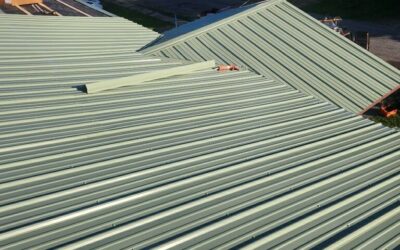What is Metal Valley Flashing? A Complete Guide by S&K Construction and Remodeling LLC
When it comes to roofing, there are many components that play crucial roles in ensuring your roof remains durable and waterproof. One of these essential components is metal valley flashing. While the term may sound technical, understanding what metal valley flashing is, its purpose, and how it contributes to your roof’s overall performance can help you make informed decisions during a roof installation or replacement.
At S&K Construction and Remodeling LLC, we specialize in roofing services throughout Northeast Ohio, including Cleveland, Lakewood, Medina, Chagrin Falls, and Youngstown. Our team of experienced professionals provides top-quality roofing installation, repairs, and replacements, ensuring that your home is protected from the elements. In this blog post, we’ll delve into everything you need to know about metal valley flashing and why it’s an essential part of a well-functioning roofing system.
What is Metal Valley Flashing?
In simple terms, metal valley flashing is a metal material installed along the valleys of a roof to direct water away from these vulnerable areas. The valleys of a roof are the intersections where two slopes meet, creating a channel for water to flow down. Without proper protection, water can infiltrate these areas, leading to leaks and water damage. Metal valley flashing is designed to prevent this by providing a durable, waterproof barrier that channels water safely off the roof.
The metal flashing is typically made of materials like aluminum, copper, or galvanized steel. The material used depends on factors like the style of the roof, the climate of the area, and the homeowner’s preference. Metal valley flashing is an important roofing component that is often overlooked, but its role is critical in maintaining the integrity of the roof and preventing water damage.

Why is Metal Valley Flashing Important?
Valleys are among the most vulnerable areas of a roof, as they direct water runoff from the two slopes. When rain or snow melts, water gathers in the valley and needs to be directed off the roof. Without proper flashing, water can seep into the roof deck and the interior of the home, leading to mold growth, wood rot, and structural damage. Metal valley flashing serves as a protective shield that channels the water away from the roof and prevents leaks.
Here are some reasons why metal valley flashing is important for your roofing system:
- Prevents Water Damage: The primary purpose of metal valley flashing is to prevent water from infiltrating the valleys of the roof. These areas are particularly vulnerable to water buildup, so it’s essential to have proper flashing to direct the water away.
- Increases Roof Lifespan: By protecting vulnerable areas, metal valley flashing helps extend the lifespan of your roof. It prevents moisture from seeping into the roof deck, which can cause premature deterioration.
- Prevents Ice Dams: In colder climates, ice dams can form at the roof’s edge, especially in the valleys where the water has nowhere to go. Metal valley flashing helps direct water away from these areas and prevents the buildup of ice that could damage the roof or cause leaks.
- Maintains Structural Integrity: Flashing prevents water from seeping into the roof structure, which can weaken the wood and compromise the structural integrity of the roof.
- Prevents Mold and Mildew Growth: Excess moisture that penetrates the roof can create a breeding ground for mold and mildew. Metal valley flashing helps prevent moisture buildup, reducing the likelihood of mold growth.
How is Metal Valley Flashing Installed?
The installation of metal valley flashing is an essential part of the roof installation or replacement process. It requires precise placement to ensure that water is effectively channeled away from the valleys.
Here’s a step-by-step guide to how metal valley flashing is typically installed:
- Preparation of the Roof Deck: Before installing the flashing, the roof deck (the wooden base layer of the roof) must be cleaned and prepared. Any debris or old roofing materials must be removed to create a smooth surface for the flashing.
- Installation of Underlayment: Roofing underlayment, such as roofing felt or ice and water shield, is applied to the roof deck. This provides an additional layer of protection against water infiltration before the flashing is installed.
- Measuring and Cutting the Flashing: The metal valley flashing is cut to the appropriate length to fit along the valley of the roof. It’s important that the flashing fits properly and extends from the ridge of the roof all the way down to the eaves.
- Laying the Flashing: The flashing is then laid in the valley, with the edges carefully aligned along the roof’s edges. It’s essential to ensure that the flashing is properly sealed and doesn’t leave any gaps where water could seep through.
- Securing the Flashing: The flashing is secured to the roof deck using nails or screws. It’s important that the flashing is fastened tightly to prevent it from shifting or becoming dislodged during heavy rain or high winds.
- Shingle Installation: Once the flashing is in place, the shingles are installed over the flashing. The shingles should overlap the edges of the flashing to create a water-tight seal. This ensures that water is channeled down the roof and over the flashing, preventing it from entering the roof deck.
Different Types of Metal Valley Flashing
There are several types of metal valley flashing that are commonly used in roofing, and each type has its advantages and is suitable for different roofing systems. The most common types of metal valley flashing are:
1. W-Valley Flashing
The W-valley is one of the most common types of metal valley flashing. It gets its name from the “W” shape it forms when installed. The flashing is shaped like a “W” and is placed in the valley to direct water down the center of the roof. The raised ridges on either side of the valley help direct the water toward the eaves.
This type of flashing is durable, and its design helps to keep water flowing smoothly down the roof. W-valley flashing is often used in asphalt shingle roofs, but it can also be used with other types of roofing materials.
2. Closed-Cut Valley Flashing
Closed-cut valley flashing is another popular option for metal valley flashing. This type of flashing is installed when the shingles are cut directly along the edge of the valley. The flashing is placed underneath the shingles, and the shingles are trimmed to fit snugly against the flashing.
The advantage of closed-cut valley flashing is that it provides a clean and seamless appearance. The shingles are trimmed carefully, creating a neat edge that covers the flashing. This type of flashing is often used in architectural shingle roofs and provides an elegant and aesthetically pleasing finish.
3. Open Valley Flashing
Open valley flashing is a style of flashing where the shingles are installed along both sides of the valley but do not cover the metal flashing completely. This creates an open, exposed appearance where the metal flashing is visible. Open valley flashing is commonly used with metal roofing or tile roofing, where the flashing is part of the overall aesthetic of the roof.
The advantage of open valley flashing is that it allows water to flow more freely, reducing the likelihood of clogs or water buildup. It also creates a distinctive look for the roof, which can be a selling point for some homeowners.
4. Valley Liner Flashing
A valley liner is a special type of metal valley flashing that includes an additional layer of waterproofing. This type of flashing often includes a self-adhesive membrane that provides extra protection against water infiltration. It’s commonly used in areas prone to extreme weather conditions or in regions with a high risk of ice dams.
Valley liner flashing is often used in combination with other types of flashing to provide a double layer of protection, ensuring that water doesn’t seep through the valley area and cause damage to the roof.
Signs That You Need Metal Valley Flashing
While metal valley flashing is generally a long-lasting and durable roofing component, there are certain signs that may indicate it’s time for replacement or repair. These include:
- Leaks or Water Damage: If you notice water stains on your ceiling or walls, it could be a sign that the valley flashing is damaged or improperly installed. Water infiltration can cause mold growth, wood rot, and structural damage.
- Damaged or Missing Flashing: If you can see that the flashing is cracked, bent, or missing in certain areas, it’s essential to have it repaired or replaced. Damaged flashing allows water to enter the roof and cause significant damage.
- Clogged Valleys: If you notice that debris, such as leaves, branches, or dirt, has accumulated in the valleys, it can cause water to back up. This increases the risk of leaks and water damage. Regular maintenance and cleaning can help prevent this issue.
- Ice Dams: In colder climates, ice dams can form along the eaves and in the valleys of the roof. Ice dams can cause water to back up and seep into the roof deck. If ice dams are a recurring issue, upgrading to a more durable metal valley flashing may be necessary to prevent further damage.
Conclusion
Metal valley flashing plays a vital role in maintaining the integrity of your roof. It ensures that water flows away from the roof’s valleys, preventing water damage, leaks, and ice dams. Properly installed flashing extends the lifespan of your roof and provides long-term protection against the elements.
At S&K Construction and Remodeling LLC, we specialize in roofing services for homeowners across Northeast Ohio. Whether you’re in Cleveland, Lakewood, Chagrin Falls, Medina, or Youngstown, we have the expertise to install or repair your metal valley flashing and ensure your roof performs at its best. Our team is committed to providing high-quality, reliable roofing solutions that protect your home for years to come.
If you’re considering a roof replacement or need assistance with your existing roof, contact S&K Construction and Remodeling LLC today for a consultation!
 (440) 307-2060
(440) 307-2060


